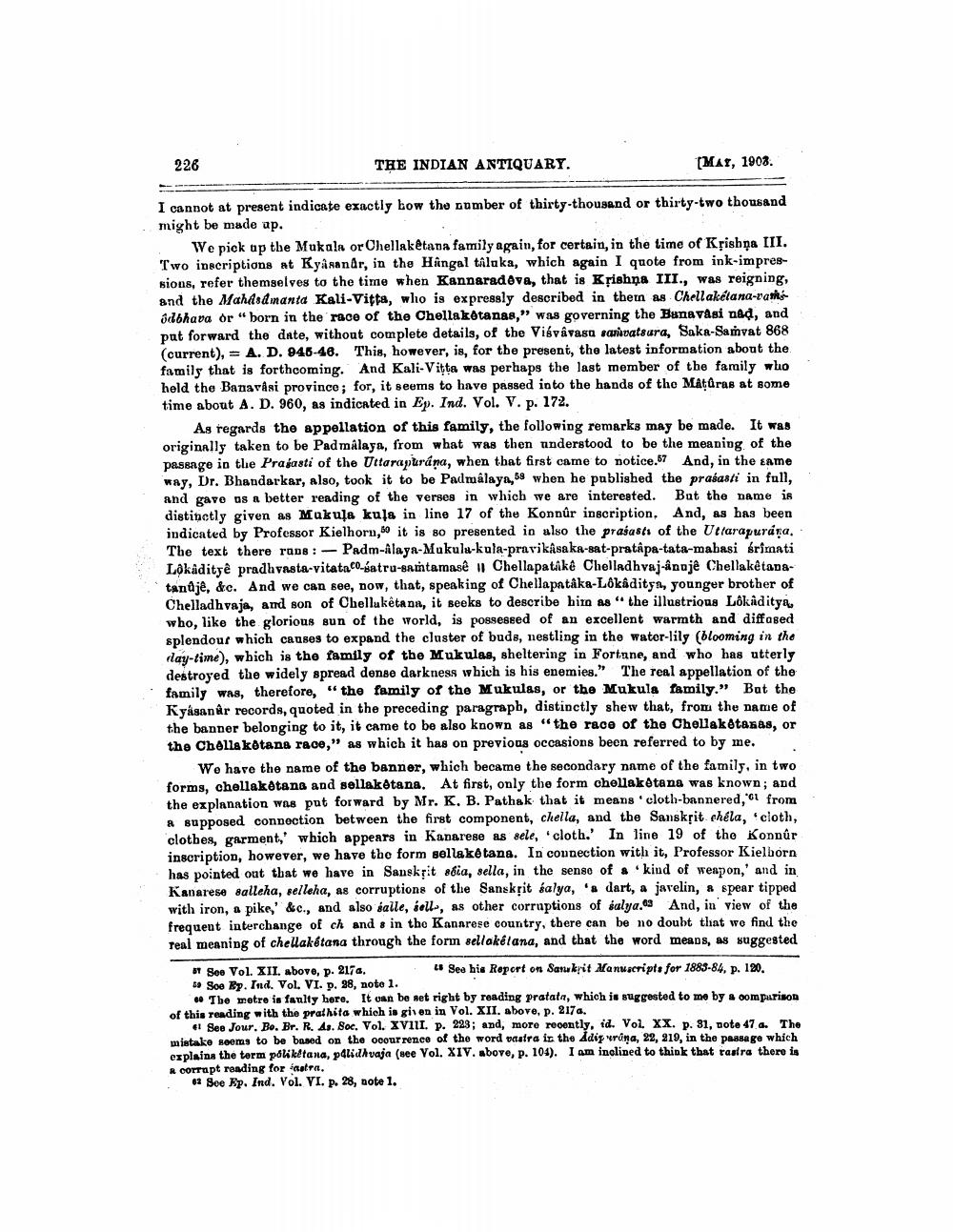________________
226
THE INDIAN ANTIQUARY.
(MAT, 1903.
I cannot at present indicate exactly how the camber of thirty-thousand or thirty-two thousand might be made ap.
We pick up the Mukala or Chellaketana family again, for certain in the time of Krishna III. Two inscriptions at Kya nanár, in the Hangal talaka, which again I quote from ink-impressions, refer themselves to the time when Kannaradova, that is Krishna III., was reigning, and the Mahasamanta Kali-Vitta, who is expressly described in thern as Chellakétana-vamaja odbhava or "born in the race of the Chellaketanas," was governing the Bunavasi ned, and pat forward the date, without complete details, of the Visvavaso sanidatsura, Saka-Samvat 868 (current), = A. D. 946-46. This, however, is, for the present, the latest information about the family that is forthcoming. And Kali-Vitta was perhaps the last member of the family who held the Banavåsi province; for, it seems to have passed into the hands of the Matūras at some time about A. D. 960, as indicated in Ep. Ind. Vol. V. p. 172.
As regards the appellation of this family, the following remarks may be made. It was originally taken to be Pad malaya, from what was then understood to be the meaning of the Pasange in the Prajasti of the Uttarapurána, when that first came to notice.57 And, in the same way, Dr. Bhandarkar, also, took it to be Padmalaya, 68 when he published the prasasti in full, and gave us a better reading of the verses in which we are interested. But the name is distinctly given as Makula kula in line 17 of the Konnûr inscription. And, as has been indicated by Professor Kielhorn, so it is so presented in also the prasasti of the Uttarapurára. The text there raps: - Padm-alaya-Makula-kula-pravikasaka-sat-pratapa-tata-mabasi érimati Lokadityê pradhvasta-vitataco-satru-samtamasê Chellapatike Chelladhyaj-annje Chellaketanstandje, &c. And we can see, now, that, speaking of Chellapatka-Lókadityn, younger brother of Chelladhvaja, and son of Obelluketann, it seeks to describe him as "the illustrious Lökaditya. who, like the glorious sun of the world, is possessed of an excellent warmth and diffosed splendour which causes to expand the cluster of buds, nestling in the water-lily (blooming in the nay-time), which is the family of the Mukulas, sheltering in Fortune, and who has utterly destroyed the widely spread dense darkness which is his enemies." The real appellation of the family was, therefore, “the family of the Mukulas, or the Mukula family.” But the Kyásanêr records, quoted in the preceding paragraph, distinctly shew that, from the name of the banner belonging to it, it came to be also known as “the race of the Chellakotaxas, or the Chelle kotana race," as which it has on previous occasions beon referred to by me,
We have the name of the banner, which became the secondary name of the family, in two forms, chellaketans and sellaketana. At first, only the form chellaketana was known; and the explanation was put forward by Mr. K. B. Pathak that it means 'cloth-bannered," from # supposed connection between the first component, chella, and the Sanskțit chéla, cloth, clotbes, garment, which appears in Kanarese as sele, cloth. In line 19 of the Konnûr inscription, however, we have the form sellaketana. In connection with it, Professor Kielborn has pointed out that we have in Sanskrit sbia, sella, in the sense of a kind of weapon,' and in Kanarese salleha, selleha, as corruptions of the Sanskrit salya, 's dart, a javelin, & spear tipped with iron, a pike' &c., and also salle, soll-, as other corruptions of salya. And, in view of the frequent interchange of ch and s in the Kanarese country, there can be no doubt that we find the real meaning of chellakétana through the form sellokélana, and that the word meads, as suggested
* Soo Vol. XII. above, p. 2170.
" See his Report on Sanukrit Manuscripts for 1883-84, p. 120. Soe Ey. Ind. Vol. VI. p. 38, note 1.
* The metro is faulty here. It onn be net right by reading pratata, which is suggested to me by a comparison of this reading with the pralhita which is given in Vol. XII. above, p. 2174.
. See Jour. B. Br. R. As. Soc. Vol. XVIII. p. 223; and, more recently, id. Vol. XX. p. 81, noto 47 a. The miatake seems to be based on the ocour rence of the word vastra in the Adirona, 22, 210, in the passage which cxplains the term poliktana, plid vaja (nee Vol. XIV. above, p. 104). I am inclined to think that rastra there is A corrupt reading for fastra.
• Soe Ep. Ind. Vol. VI. p. 28, note 1.




